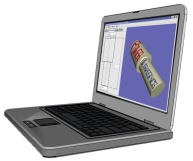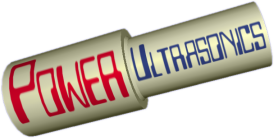A new online ultrasonics components store has just opened at www.UltrasonicsWorld.com. Check their amazing prices for replacement ultrasonics components, fully compatible with the major manufacturers' originals at a fraction of the cost.
You are here
Hand-piece Housing/cover
I visited your forum recently. I liked all the correspondences and transfer of know-how to people who really need it. You are doing a great work.
I am a mechanical design engineer with no experience in Ultrasonic processing. I have started reading about the basic concepts and got a lot from your web site and manufacturers' web sites . I do not have a device and I do not know yet when I will acquire one. At this moment, I am interested to know the design of a system used to cut (plunge cut in the axial direction) soft materials like meat or potatoes. I have a couple of questions?
1- I would like to attach a stationary housing or handle that covers the hand-piece all the way to the frontal tip close to the tool. The purpose of such a housing may be to locate the tool tip precisely. I assume that the housing should be connected to a nodal flange or flanges. The nodal flange I think may be on the frontal mass or the booster or the horn? The nodal point with zero amplitude is a line contact (like a shoulder on a stepped horn). We know that a flange has a finite width. What is the effect of a wider flange at the nodal point? How is the flange connected to the horn? Can a housing be connected at more than one nodal flanges assuming that a booster and a horn are used? Can I find some example drawings somewhere?
2. Is it possible to get a rotary ultrasonic motion and how? Where can I get some literature to read? Are there manufacturing companies out there?


Re: Hand-piece Housing/cover
Hi Tes,
Welcome to the forum. Thanks for your kind word and questions (so many questions...!)
[quote="Tes "]
I assume that the housing should be connected to a nodal flange or flanges. The nodal flange I think may be on the frontal mass or the booster or the horn?[/quote]
Yes, it's common to support the system on a nodal flange on the booster, but also possible to use a flange on the sonotrode itself. A good reason for supporting the sonotrode directly would be to maintain its location / alignment more accurately. However this is generally a more expensive way to do it because the sonotrode is a custom component subject to many other design constraints and also a wear part.
[quote="Tes "]
We know that a flange has a finite width. What is the effect of a wider flange at the nodal point? How is the flange connected to the horn?[/quote]
There are a few ways it can be done. Often there is a small flange machined as part of the booster itself with the main mounting flange in two parts clamped across it. Flange design, like many other things in this industry, is more complicated than it may appear. On the basis that the flange is at a nodal point you might think that it's stationary so any size / shape / design would be ok. There are two problems with this:
1. It isn't stationary! Although at a nodal point there should be no axial movement (provided it's designed and built just right) there will still be radial motion caused by the linking of strain in the axial and radial directions. Poisson's ratio for most metals is around 0.3, which means that the amplitude of the cyclic radial strain in the nodal section will be about 30% of the axial strain. For most sonotrodes the diameter is less than one third of the length so when we look at the radial motion of the flange this strain converts to no more than about 10% of the sonotrode amplitude, but still that can be significant. I've tried to illustrate this in the animation on the [url=http://www.powerultrasonics.com/sonotrode_calculator.html]sonotrode calculator page[/url].
2. The flange may have its own resonance modes. I believe this is the main reason for keeping the real flange (the machined section of the main sonotrode) as small as possible - it's generally a thin section and thin sections will vibrate in diaphragm modes (think of the vibrations of a speaker cone). And if the flange has a resonant frequency close to the operating frequency of your system then it could act as a vibration absorber, soaking up all the energy from your generator and converting it to flange motion (at least, this might happen for a few milliseconds before it fractured!).
[quote="Tes "]
Can a housing be connected at more than one nodal flanges assuming that a booster and a horn are used? Can I find some example drawings somewhere?[/quote]
Yes, but beware of overconstraining the system. At the very least you'd need to allow for thermal expansion in the axial direction. Unfortunately for reasons discussed above flange design tends to be either specific to the application or regarded as proprietory information. If you can mount your system on the booster flange then you don't need to worry about it (just get a standard booster) and if you're mounting on the sonotrode it will require custom design anyway.
[quote="Tes "]
2. Is it possible to get a rotary ultrasonic motion and how? Where can I get some literature to read? Are there manufacturing companies out there? [/quote]
There are many manufacturing companies out there producing weird and wonderful ultrasonic devices! The hard part sometimes can be finding the right one. In this case, did you mean an axial-mode system that rotates (like an ultrasonic drill) or an ultrasonic system that vibrates in a torsional mode, giving a rotational vibration of the tip?
Ultrasonic drills have been around for many years, although mostly at the small scale (dental and jewellery). In terms of the ultrasonic technology it's not that difficult to send the transducer power through slip-rings. (Edit: and the NASA mars-lander application may give this technology a boost shortly!)
Rotational ultrasonic systems are more of a rarity, but Telsonic recently introduced a range of [url=http://www.telsonic.com/haupt.asp?nv=2142&spr=2]torsional-mode metal-welding systems[/url] which look interesting.
HTH
Chris